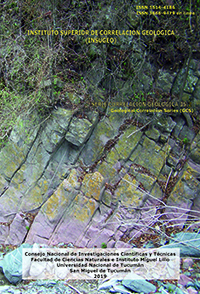Serie Correlación Geológica 35 (2)
Geochemical characterization of the gneisses and schists in Ekumtak area: further evidence for a metasedimentary protolith and moderate weathering intensity for the Precambrian Basement complex of Nig
Descargar trabajo en formato PDFResumen
CARACTERIZACIÓN GEOQUÍMICA DE GNEIS Y ESQUISTOS EN EL ÁREA DE EKUMTAK: MÁS EVIDENCIA DE UN PROTOLITO METASEDIMENTARIO Y UNA INTENSIDAD DE METEORIZACIÓN MODERADA PARA EL COMPLEJO DEL SÓTANO PRECÁMBRICO DE NIGERIA. El área de estudio se caracteriza por gneis con bandas migmatíticas y esquistos de mica granate. Estas rocas están asociadas con intrusiones graníticas y anfibolíticas. Estos gneis y esquistos migmatíticos se caracterizan por conjuntos de minerales paragenéticos que reflejan una historia evolutiva que involucró procesos de sedimentación y metamorfismo de facies de anfibolitas superiores. Los datos geoquímicos muestran que las rocas son ricas en sílice con concentraciones moderadas a elevadas de Al2 O3, lo que es consistente con las rocas pelíticas. Los gneises muestran anomalías positivas en Rb, K, Th, La, Sm y fuertes anomalías negativas en Ta, Nb, Sr, Ti, Tm, Yb, Zr e Y, con un enriquecimiento general de los elementos litófilos de iones grandes (LILE: K, Ba y Rb) y el agotamiento de los elementos de alta intensidad de campo (HFSE: Zr, Ti e Y). Específicamente, las Eu-anomalías, expresadas como (Eu / Eu *) varían de 0.03 a 1.4 en los gneises y de 0.09 a 1.1 en los esquistos. Las relaciones LaN / YbN son de 7 a 93 para los gneises y de 1,9 a 46,4 para el esquisto. Estos valores sugieren que los protolitos de estas rocas metasedimentarias son predominantemente lutitas, grauvacas y areniscas arkósicas con componentes volcánicos surbodinados básicos a intermedios. Su índice químico de valores de alteración varía de 57.7 a 71.7 en los gneises y 66.6 a 74.9 en los esquistos con una media de 68% y una desviación estándar de ± 3.4, lo que sugiere un proceso de reciclaje y una meteorización química relativamente moderada de los protolitos. El origen metasedimentario de las rocas es consistente con los resultados de otras partes del complejo del Sótano Precámbrico de Nigeria.
Abstract
The study area is characterized by migmatitic banded gneisses and garnet mica schists. These rocks are associated with amphibolite and granitic intrusions. These migmatitic gneisses and schists are characterized by paragenetic mineral assemblages that reflect an evolutionary history that involved processes of sedimentation and upper amphibolite facies metamorphism. Geochemical data show that the rocks are silica rich with moderate to elevated concentrations of Al2 O3 which is consistent with pelitic rocks. The gneisses show positive anomalies in Rb, K, Th, La, Sm and strong negative anomalies in Ta, Nb, Sr, Ti, Tm, Yb, Zr and Y, with an overall enrichment of the large ion lithophile elements (LILE: K, Ba and Rb) and depletion of the high field strength elements (HFSE: Zr, Ti and Y). Specifically, the Eu-anomalies, expressed as (Eu/Eu*) range from 0.03 to 1.4 in the gneisses and from 0.09 to 1.1 in the schists. LaN/YbN ratios are from 7 to 93 for the gneisses and 1.9 to 46.4 for the schist. These values suggest that the protoliths of these metasedimentary rocks are predominantly shales, greywackes and arkosic sandstones with surbodinate basic to intermediate volcanic components. Their chemical index of alteration values ranges from 57.7-71.7 in the gneisses and 66.6-74.9 in the schists with mean of 68% and standard deviation of ±3.4 suggesting a recycle process and relatively moderate chemical weathering of the protoliths. The metasedimentary origin for the rocks is consistent with results from other parts of the Nigerian Precambrian Basement complex.






